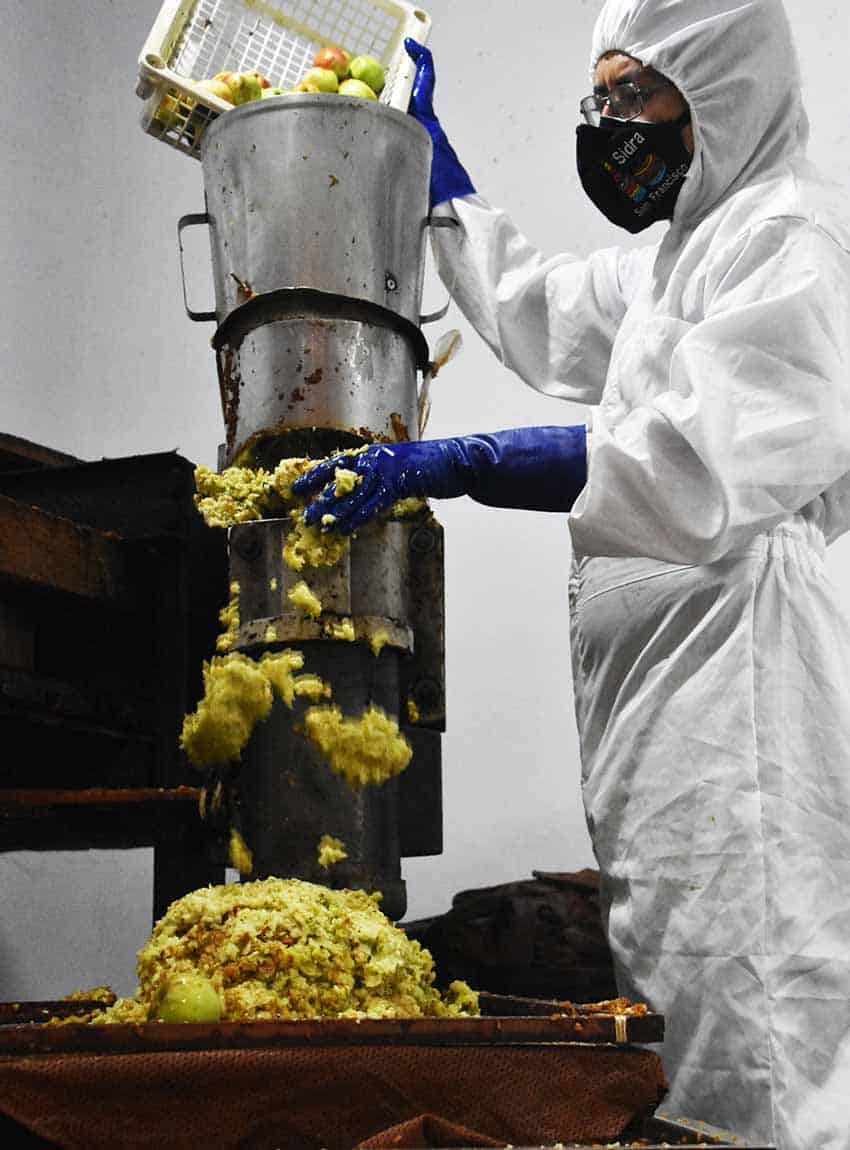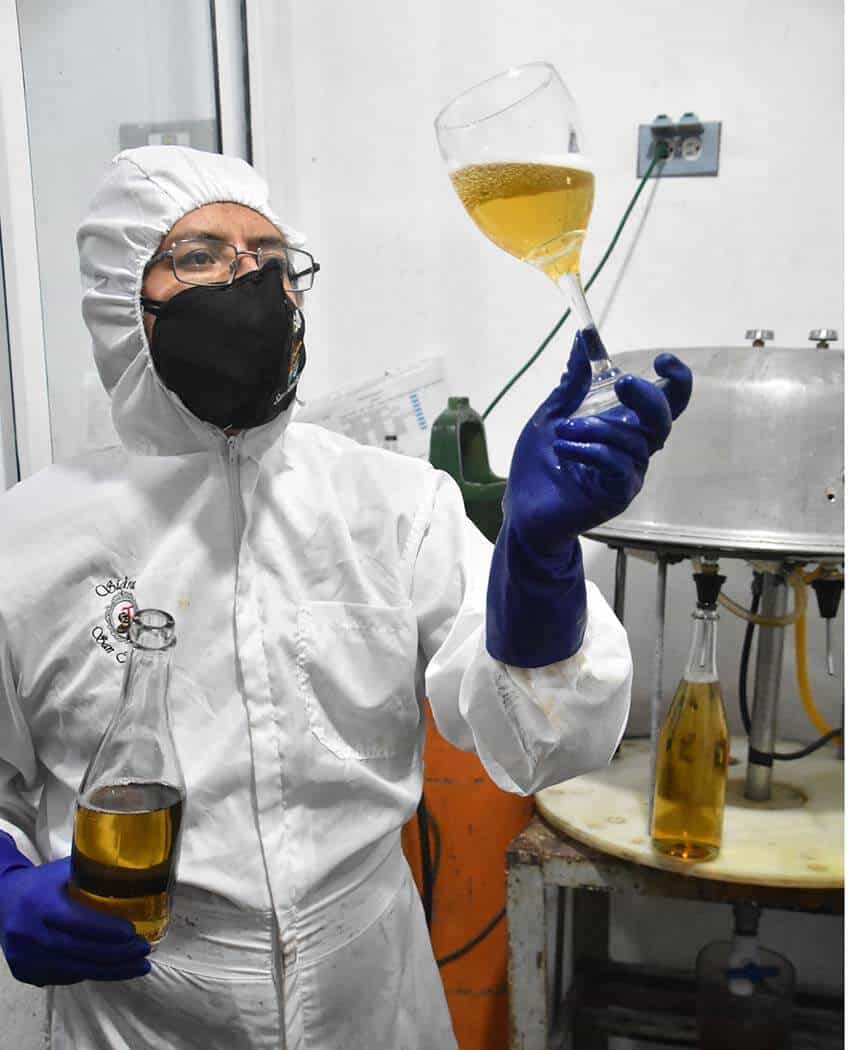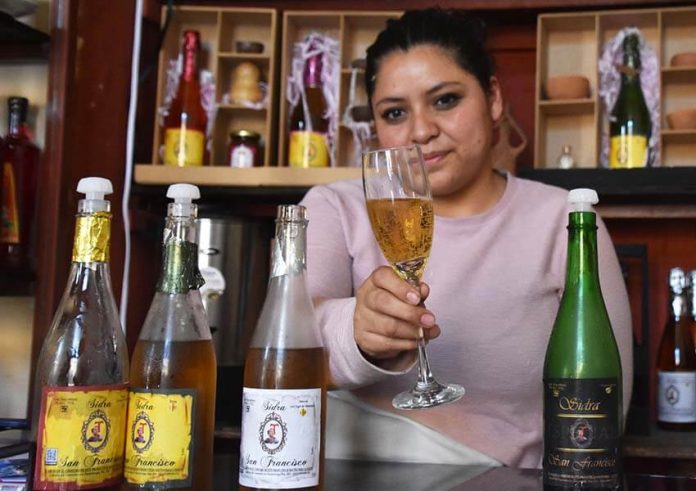In a small room behind the counter at cider makers Sidra San Francisco, Gabriel Hernández García makes sidra (hard cider) the same way his great-grandfather, Gabriel Guerrero Miruela, learned to do it almost 100 years ago: completely by hand.
“A French chef taught my bisabuelo in 1927,” he said, “and he passed the information to his sons.”
The chef’s full name has been lost, but his surname may have been Prago and the techniques he taught Guerrero continue to be passed down faithfully. Hernández worked in his grandmother’s fábrica (factory, or in this case, cider mill), Sidra San Gabriel, for four years, learning how to make the beverage. Through four generations, “the recipe has not changed,” he said.
Sidra is a very old drink. No one knows when it was first made, but it’s known that Celts in Britain were making it at least 3,000 years ago. When Julius Caesar made his first attempt to invade in 55 B.C., he and his soldiers became so enamored with the drink they brought it back with them and left the first written record of it. Very soon, sidra spread across the Roman Empire and throughout Europe.
It took a couple of thousand years, but the drink finally caught on in Mexico when Prago transferred the knowledge of how to make it to Hernández’s great-grandfather. Today, sidra is served at many celebrations in Mexico, including quinceañera parties, weddings and other fiestas. It is especially popular at Christmas and New Year’s.

Sidra is popular in Spain, especially in the apple-growing region of Asturias, but the conquistadors apparently didn’t bring it with them when they arrived in Mexico. And because Guerrero was taught by a Frenchman, “the sidra made here is more similar to that made in France,” said Hernández.
He makes his sidra in Huejotzingo, Puebla, a small city that’s about 25 miles northwest of Puebla city. It’s become famous for the beverage and currently boasts around 30 sidra makers. Hernández figures 70% of the owners are members of his family. His own fábrica is small, the crew consisting of Hernández; his wife, Andrea Martínez Castillo; one son; and two other employees.
Hernández uses only Perón apples, which are grown in orchards surrounding Popocatépetl, an active volcano. “We use these apples because they have a good level of acid and they are flavorful,” García said.
Although Hernández starts making sidra in April, using about 200 pounds of apples a month through June, production doesn’t really crank up until later in the summer. Then, said Martínez, “we use four tonnes a month in July and August.”
In the back room, where the air is perfumed with the smell of the fruit, Hernández dips a basket into a concrete tub where apples are being washed. He loads them into a grinder to make a pulp he called gabazo. “This is given to animals to eat,” he said. “Horses, cows, pigs. We have no waste. We use everything.”
The pulp lands on a cloth that covers slatted wooden trays made from old apple trees. Once about 20 pounds of apples have been ground, Hernández gently spreads the pulp evenly, folds the cloth over it and places several more trays on top.
He then swings the tray into position, where a small hydraulic pump is used to apply pressure, squeezing out the juice. In an eight-hour day, Hernández can grind one tonne of apples, from which he will eventually make 1,600 bottles of sidra.
The resulting liquid is transferred to 200-liter oak barrels, where it is left to ferment. They only use oak because, explained García, “The oak imparts flavor to the sidra.”
The fermentation step takes around three months and is all-natural. “The apple seeds contain yeast, and this is what drives the fermentation,” Hernández said. “We do not add yeast.” Yeast is released from the seeds’ shells when the apples are crushed.
“We do not stop the fermentation,” he continued. “When the yeast has used up all the sugars in the juice, the yeast dies and precipitates. The liquid that is left is clear and brilliant. We move that to another barrel.
“We fill that barrel to the top, put on a cover and seal it with paraffin. We control the light, temperature, humidity. These are in another place where they cannot be disturbed. The liquid will mature for three years, and then we will bottle it.”
Hernández’s sidra is aged significantly longer than some others.

“The juice is aged three years in oak barrels so that it acquires a better quality and flavor,” García said. “This yields a natural gasification and amount of alcohol. We give it this much time to achieve the notes and flavors that characterize sidra from Sidra San Francisco.”
The final step in the production is bottling the juice. Hernández estimates he can produce about 96,000 bottles a year. A small machine directs the juice into bottles, but all the other steps — hammering a plastic cap into the bottle’s neck, twisting on a thin wire to secure the cap in place, adding a gold wrap to the neck and, finally, placing a label on the bottle — are all done by hand.
Sidra is low in alcohol. Hernández’s is 3% while some others are just slightly higher at 3.5%. Like other producers, Sidra San Francisco sells several types.
The most popular is ambar, also called champagne which, as its name suggests, has an amber color. They also sell fruit-flavored sidras, including pear, tangerine, peach, pomegranate, blackberry and strawberry. “The flavored sidras are 60% apple juice and 40% other fruit,” said García. They also make rosada, a sidra that is mixed with wine.
After all of the apples are harvested and the juice is aging in barrels, Hernández turns his attention to making wine, using grapes from Santa Rita, a small town in Puebla.
“We make our own because we have the experience,” García said. “We have experimented and determined how to make the most flavorful wine.” Their rosada is aged in oak barrels for an additional year.
Some makers offer a nonalcoholic sidra, but Hernández reacted strongly when asked about that. “To be called sidra, it must be fermented apple juice,” he said. “It is natural alcohol; none is added. Sidra without alcohol is not sidra.”
When asked why he continues to make sidra in such a difficult and time-consuming way, Hernández doesn’t hesitate in his response.
“When I was young, my grandmother transmitted this love of sidra to me,” he said. “She took me to the fábrica, and I saw the process.”
That love will be passed to the next generation, he said. “I will teach my children.”
Sidra San Francisco has two locations. In Huejotzingo, where the fábrica is located, they’re in an alley opposite the ex-convent on Callejón del Convento in Barrio Centro. The store in Cholula is located at Avenida Morelos 212. More information may be found on their Facebook business page.
Joseph Sorrentino, a writer, photographer and author of the book San Gregorio Atlapulco: Cosmvisiones and of Stinky Island Tales: Some Stories from an Italian-American Childhood, is a regular contributor to Mexico News Daily. More examples of his photographs and links to other articles may be found at www.sorrentinophotography.com He currently lives in Chipilo, Puebla.
